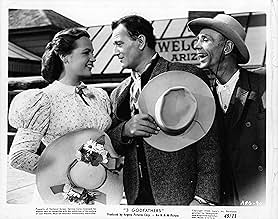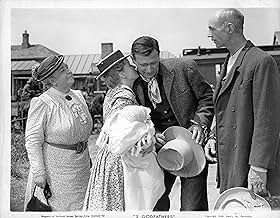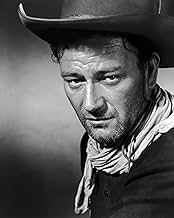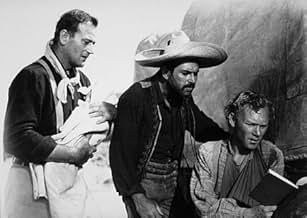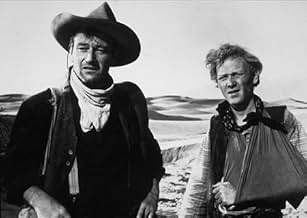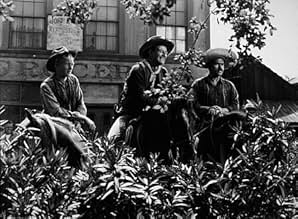AVALIAÇÃO DA IMDb
7,0/10
11 mil
SUA AVALIAÇÃO
Três bandidos em fuga arriscam sua liberdade e suas vidas para devolver um bebê recém-nascido à civilização.Três bandidos em fuga arriscam sua liberdade e suas vidas para devolver um bebê recém-nascido à civilização.Três bandidos em fuga arriscam sua liberdade e suas vidas para devolver um bebê recém-nascido à civilização.
- Direção
- Roteiristas
- Artistas
Pedro Armendáriz
- Pedro Roca Fuerte
- (as Pedro Armendariz)
Gertrude Astor
- Saloon Girl
- (não creditado)
Nora Bush
- Townswoman
- (não creditado)
Avaliações em destaque
`Three Godfathers' is cinematographically one of John Ford's finest looking Westerns. The location filming is breathtaking and comes as close as can be found in capturing the beauty of Death Valley. That the story is relatively straightforward, pretty fairly untenable and in Ford fashion highly sentimental is rather inconsequential. This is a great looking movie shot primarily in one of the most starkly striking places on Earth.
John Wayne, Pedro Armendáriz and Harry Carey Jr. (one of his first roles) are bank robbers on the run, saddled with an infant they have promised to care for to its dying mother. They plunge into desperate straights as they flee across the desert. That no part of Death Valley lies close to Arizona (the story is set there) is of no account but again as in all Ford movies his vision of the American West ignores the hundreds of thousand square miles that is not Utah, Monument Valley, or as in this case, Death Valley. And that he pioneered an American View Of The West is undeniable.
Winton C. Hoch was responsible for the cinematography; he later demonstrated his art in `The Searchers' (most famous) and actually won an Oscar for `She Wore A Yellow Ribbon'. His use of color film was extraordinary and any movie he made is best viewed on the big screen.
There are numerous references to Christian views of morality sprinkled throughout the movie; Christmas is revered as the traditional American celebration, a Bible figures in Wayne's worst moments as he struggles against the wilderness and the songs we hear are primarily religious hymns. That some good comes of the efforts of the trio is redemptive enough to raise this effort above the average Western.
It is doubtful this movie could be shot again. It is exceedingly unlikely the disturbance a film crew would make while filming in a national park would be permitted. Try to imagine the rails required for the cameras being laid today.
Score: Three Stars
John Wayne, Pedro Armendáriz and Harry Carey Jr. (one of his first roles) are bank robbers on the run, saddled with an infant they have promised to care for to its dying mother. They plunge into desperate straights as they flee across the desert. That no part of Death Valley lies close to Arizona (the story is set there) is of no account but again as in all Ford movies his vision of the American West ignores the hundreds of thousand square miles that is not Utah, Monument Valley, or as in this case, Death Valley. And that he pioneered an American View Of The West is undeniable.
Winton C. Hoch was responsible for the cinematography; he later demonstrated his art in `The Searchers' (most famous) and actually won an Oscar for `She Wore A Yellow Ribbon'. His use of color film was extraordinary and any movie he made is best viewed on the big screen.
There are numerous references to Christian views of morality sprinkled throughout the movie; Christmas is revered as the traditional American celebration, a Bible figures in Wayne's worst moments as he struggles against the wilderness and the songs we hear are primarily religious hymns. That some good comes of the efforts of the trio is redemptive enough to raise this effort above the average Western.
It is doubtful this movie could be shot again. It is exceedingly unlikely the disturbance a film crew would make while filming in a national park would be permitted. Try to imagine the rails required for the cameras being laid today.
Score: Three Stars
Nice to watch this hoary old (Christmas) chestnut at Yuletide, almost exactly 60 years after its original release. And yes, while it is guilty of a number of sins by way of corniness, improbability and sentimentality, it still works for me and proves you don't need tinsel and snow to evoke the Christmas spirit. Here old Papa Ford relates his Christmas parable against the background of the searing heat of the Arizona desert as Duke Wayne struggles against the odds to deliver orphan child Robert William Pedro to safety, bang on, wouldn't you know it, Christmas Day. All the usual Ford staples are here, the panoramic scenery, male camaraderie, bawdy humour and of course big John Wayne himself in yet another barnstorming lead role. I'm not the biggest Wayne fan going, but Ford invariably got the best out of the big lunk and he certainly carries the film (and the baby!) manfully. His two confederates, the youthful Harry Carey Jr and TexMex Pedro Armendariz both of whom sadly expire along the way, offer effective and humorous counterpoint to big John's proselytising. Ford cleverly doesn't reveal his hand too quickly with only the odd Biblical reference alluded to early on but by the time the three amigos are spotlit gazing out at the camera having just accepted the dying mother's infant child into their care, it piles on from there. Along the way the humour and sentimentality are mixed up lightly with a little (not too much) dramatic tension as Wayne completes his epic journey (like he was ever going to fail!), spurred on by the ghosts of his fallen colleagues and completes his own spiritual regeneration in accepting with good grace his jail sentence at the end in exchange for a guarantee that he'll be reunited with his infant charge once his sentence is complete. Noting that the film is Ford's own remake of his earlier silent movie production of the same story would help explain why some of the scenes are somewhat static and staged tableau-style. Wayne gets to walk more than he talks, no bad thing, and the rest of the cast are all at home under the director's loving eye. All told, then a colourful (check the blue filter shot Ford employs to evoke the desert at night) and festive treat. But surely this child wasn't the Son of God...?!
Redemption is the keyword to many a Ford work:this is perhaps the most convincing effort in a remarkable career for that matter.Like all the great auteurs,western is only an alibi for Ford to convey a message:God is the only way,the Bible is the only book for Man's education (as Dr Whatsisname's infant care manual for the new human being).
If you do not know anything about the screenplay and you expect a traditional western ,you may be disappointed:actually it might as well be a Xmas tale.Actually ,only the beginning and the ending are what you expect from a western.The central part is Robert's (Wayne) road to Damascus.His two pals do believe in God,he doesn't.The desert and the quest of water are a metaphor for the emptiness of his heart.In the second part of the movie,he's like the baby,busy being born.
Ford's movie is a visual splendor:the three men filmed against the sunlight near the mother's grave;the grave shot in close-up as the three men go away.The desert itself becomes an almost alive entity,filmed with a unique sense of space .Narration avoids readiness:when Wayne meets the mother,Ford does not show the scene:he lets his character tell it to his friends.The mother briefly appears for one short scene but she makes all her words count.
Singing is very important:when the mother is buried ,William sings over his grave but he cannot finish his canticle because he cannot remember the end:thus Ford avoids pathos and melodrama;when he rocks the baby,he sings "streets of Laredo",an ominous choice(but lullabies are sometimes strange and even cruel,aren't they?);the final choir "bringing in the sheaves" signals a brand new life for Robert. Towards the end ,the movie verges on fantastic ,which is extremely rare in the western genre.
Biblical quotations abound,but anyway,they are everywhere in Ford's work from the earlier works (the informer) to the later ones (seven women).
In the eighties,Coline Serreau made a shameless rip -off "trois hommes et un couffin".It wasn't a western ,the action taking place in Paris 1985,but a lot of ideas were taken from Ford .Besides,her three characters were despicable machos:One wishes it had not come from a woman .The movie was such a huge success that the American felt compelled to redo it (three men and a baby).Forget these mediocrities and do watch the Master 's tale of redemption.
If you do not know anything about the screenplay and you expect a traditional western ,you may be disappointed:actually it might as well be a Xmas tale.Actually ,only the beginning and the ending are what you expect from a western.The central part is Robert's (Wayne) road to Damascus.His two pals do believe in God,he doesn't.The desert and the quest of water are a metaphor for the emptiness of his heart.In the second part of the movie,he's like the baby,busy being born.
Ford's movie is a visual splendor:the three men filmed against the sunlight near the mother's grave;the grave shot in close-up as the three men go away.The desert itself becomes an almost alive entity,filmed with a unique sense of space .Narration avoids readiness:when Wayne meets the mother,Ford does not show the scene:he lets his character tell it to his friends.The mother briefly appears for one short scene but she makes all her words count.
Singing is very important:when the mother is buried ,William sings over his grave but he cannot finish his canticle because he cannot remember the end:thus Ford avoids pathos and melodrama;when he rocks the baby,he sings "streets of Laredo",an ominous choice(but lullabies are sometimes strange and even cruel,aren't they?);the final choir "bringing in the sheaves" signals a brand new life for Robert. Towards the end ,the movie verges on fantastic ,which is extremely rare in the western genre.
Biblical quotations abound,but anyway,they are everywhere in Ford's work from the earlier works (the informer) to the later ones (seven women).
In the eighties,Coline Serreau made a shameless rip -off "trois hommes et un couffin".It wasn't a western ,the action taking place in Paris 1985,but a lot of ideas were taken from Ford .Besides,her three characters were despicable machos:One wishes it had not come from a woman .The movie was such a huge success that the American felt compelled to redo it (three men and a baby).Forget these mediocrities and do watch the Master 's tale of redemption.
A really touching, naive, heart-warming Christmas movie, even if it may be quite a tear-jerker, especially at it's end: great cinematography - watch out for the wonderful impressions of the desert (the director of cinematography started with documentaries) -, great direction and one of John Wayne's best performances - this man was not only a big star, he was a wonderful actor, too!!! Between the end of the forties and the end of the fifties Ford knew how to lead Wayne to an artistic peak. And, not to forget of course: Hank Worden, Ben Johnson, Ward Bond, Pedro Armendariz, Harry Carey jr, ... what an ensemble did Ford build up around himself!!! Highly recommended to all those who want their hearts to be touched in rough times during a cold winter evening ...
I'm surprised this one doesn't get more accolades. To me it's really one of the best westerns ever made. This is one of those films that proves that the western genre can produce true art. The filming, the performances -- this is one of Wayne's best
it's quite overlooked that this guy could act: The desperation, the confusion, the exhaustion, it's all just amazing.
It's more of a character study than anything else, with the characters facing desperate thirst, an aching empty land, relentless sun, and the movie shows how these men deal with it, all the while they are attempting to care for a child. Something they are ill equipped to do.
There are clear religious elements to the movie, and they make this all the more compelling -- these are not good men, but they have a sense of honor and faith, in their own way. They can't break their word to a dying woman, to care for her child. Their faith in each other is touching.
It's gritty, yet very tender, a strange juxtaposition, like the beauty and cruelty of the desert.
See the movie if you can.
It's more of a character study than anything else, with the characters facing desperate thirst, an aching empty land, relentless sun, and the movie shows how these men deal with it, all the while they are attempting to care for a child. Something they are ill equipped to do.
There are clear religious elements to the movie, and they make this all the more compelling -- these are not good men, but they have a sense of honor and faith, in their own way. They can't break their word to a dying woman, to care for her child. Their faith in each other is touching.
It's gritty, yet very tender, a strange juxtaposition, like the beauty and cruelty of the desert.
See the movie if you can.
Você sabia?
- CuriosidadesJohn Wayne was badly sunburned while filming this movie and was briefly hospitalized.
- Erros de gravaçãoShortly after the three riders enter the desert Hightower discovers that Pedro's water bag is empty and throws it away. As they ride away in a long shot, the water bag is still visible on Pedro's horse.
- Citações
Pedro "Pete' Roca Fuerte: [dying] Hey, Bob... I just remembered what tomorrow is. Feliz Navidad.
- Trilhas sonorasBeautiful River (Shall We Gather at the River)
(uncredited)
Written by Robert Lowry and Charles Ives
Performed by Harry Carey Jr.
Principais escolhas
Faça login para avaliar e ver a lista de recomendações personalizadas
- How long is 3 Godfathers?Fornecido pela Alexa
Detalhes
- Data de lançamento
- País de origem
- Centrais de atendimento oficiais
- Idiomas
- Também conhecido como
- Tres hijos del diablo
- Locações de filme
- Empresa de produção
- Consulte mais créditos da empresa na IMDbPro
Bilheteria
- Orçamento
- US$ 1.243.000 (estimativa)
- Tempo de duração
- 1 h 46 min(106 min)
- Proporção
- 1.37 : 1
Contribua para esta página
Sugerir uma alteração ou adicionar conteúdo ausente


